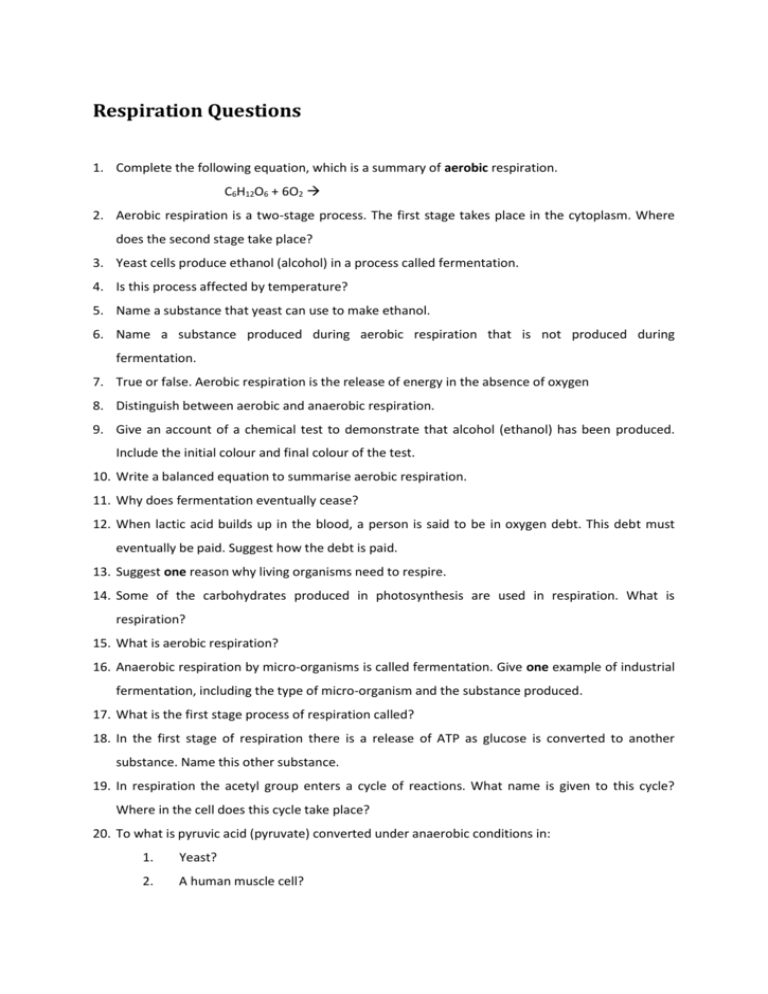Respiration
advertisement

Respiration Questions 1. Complete the following equation, which is a summary of aerobic respiration. C6H12O6 + 6O2 2. Aerobic respiration is a two-stage process. The first stage takes place in the cytoplasm. Where does the second stage take place? 3. Yeast cells produce ethanol (alcohol) in a process called fermentation. 4. Is this process affected by temperature? 5. Name a substance that yeast can use to make ethanol. 6. Name a substance produced during aerobic respiration that is not produced during fermentation. 7. True or false. Aerobic respiration is the release of energy in the absence of oxygen 8. Distinguish between aerobic and anaerobic respiration. 9. Give an account of a chemical test to demonstrate that alcohol (ethanol) has been produced. Include the initial colour and final colour of the test. 10. Write a balanced equation to summarise aerobic respiration. 11. Why does fermentation eventually cease? 12. When lactic acid builds up in the blood, a person is said to be in oxygen debt. This debt must eventually be paid. Suggest how the debt is paid. 13. Suggest one reason why living organisms need to respire. 14. Some of the carbohydrates produced in photosynthesis are used in respiration. What is respiration? 15. What is aerobic respiration? 16. Anaerobic respiration by micro-organisms is called fermentation. Give one example of industrial fermentation, including the type of micro-organism and the substance produced. 17. What is the first stage process of respiration called? 18. In the first stage of respiration there is a release of ATP as glucose is converted to another substance. Name this other substance. 19. In respiration the acetyl group enters a cycle of reactions. What name is given to this cycle? Where in the cell does this cycle take place? 20. To what is pyruvic acid (pyruvate) converted under anaerobic conditions in: 1. Yeast? 2. A human muscle cell? 21. Under aerobic conditions pyruvic acid (pyruvate) is converted to an acetyl group and in the process a small molecule is released. Name this small molecule. 22. Identify X and Y in the following equation which is a summary of aerobic respiration. C6H12O6 + 6X 6Y + 6H20 23. If yeast cells are kept under anaerobic conditions, alcohol (ethanol) and another substance are produced. (i) What are anaerobic conditions? (ii) Name the other substance produced. 24. What is anaerobic respiration? 25. Does the first stage of respiration require oxygen? 26. Comment on the amount of energy released in the first stage of respiration. 27. What name is given to the first stage of respiration? 28. Where in the cell does the second stage of respiration take place? 29. Where in a cell does this first stage of respiration take place? 30. Does the second stage of respiration require oxygen? 31. To what substance is glucose normally converted in the first stage of respiration? Is oxygen required for this conversion? 32. Comment on the amount of energy released in the second stage of respiration. 33. Name a compound to which pyruvic acid (pyruvate) may be converted, in the absence of oxygen. 34. State two ways in which the energy that is released during respiration is used in the human body. 35. Which stage of respiration releases more energy? 36. Explain briefly what is meant by respiration. 37. In stage 1 of respiration, glucose is partly broken down. Where in the cell does this happen? 38. Distinguish between aerobic and anaerobic respiration. 39. The first stage of respiration takes place in the cytosol. What is the cytosol? 40. Does the first stage of respiration release a small or large amount of energy? 41. Where in the cell does the second stage of aerobic respiration take place? 42. Is oxygen required for the second stage of aerobic respiration? 43. Suggest a situation in which some cells in the human body may not be able to engage in the second stage of aerobic respiration 44. True or false. Stage 1 of respiration requires oxygen. 45. True or false. Stage 1 of respiration takes place in the cytoplasm. 46. True or false. Stage 2 of respiration takes place in the cytoplasm. 47. True or false. Some of the energy released in respiration is lost as heat. 48. Where does the second stage of respiration take place? 49. What substance, other than ethanol, is produced during fermentation? 50. Where in the cell does the first stage of respiration occur? 51. Where in the cell does the first stage of respiration take place? 52. Give two industrial uses of the anaerobic respiration of yeast. 53. Suggest a role for NAD / NADP+ in cell activities. 54. What name is given to the first stage of respiration? 55. The first stage ends with the formation of pyruvate (pyruvic acid). In anaerobic conditions, what is produced from this pyruvate: 1. In muscle cells, 2. In yeast cells? 56. If conditions are aerobic, pyruvate next passes to an organelle in which the second stage of respiration takes place. Name this organelle. 57. Pyruvate is broken down to CO2 and a two-carbon compound. Name this two-carbon compound. 58. This two-carbon compound passes directly into a series of reactions in the second stage of respiration. Name this series of reactions and give one product, other than electrons, of these reactions. 59. The electrons released from the above reactions pass along a transport chain and in the process energy is released. 1. To what use is this energy put? 2. At the end of the transport chain what happens to the electrons? 60. What is meant by the term aerobic respiration? 61. Aerobic respiration takes place in two main stages – stage 1 and stage 2. Indicate clearly in your answer book whether each of the following statements refers to stage 1 or to stage 2. A. Takes place in the mitochondria. B. Produces a large amount of energy. C. Takes place in the cytoplasm. D. Does not require oxygen. 62. One of your practical activities was to prepare alcohol using yeast. In your answer book answer the following questions in relation to this activity: A. Name the solution in which you placed the yeast at the start of the activity. B. Give the temperature at which you then kept the solution. C. How did you know that alcohol production had ceased? D. Name the test or chemical(s) used to show that alcohol had been produced. 63. The process of respiration occurs in two stages, Stage 1 and Stage 2, that take place in different parts of the cell. Say where in the cell Stage 1 occurs and where in the cell Stage 2 occurs. Does the whole process release a large amount or a small amount of energy? 64. Write a word equation to show what happens when yeast breaks down glucose in the absence of oxygen. 65. Give one industrial application of yeast breaking down glucose in the absence of oxygen. 66. When muscles break down glucose in the absence of oxygen, one main product is produced. Name this product. 67. Which biological process is represented by the following word equation: glucose + oxygen → carbon dioxide + water + energy? 68. Give two reasons why living things need energy. 69. Name a substance required for aerobic respiration 70. Name a product of anaerobic respiration found in muscles 71. Name a product of aerobic respiration 72. Name a product of anaerobic respiration in yeast 73. Where in the cell does stage two respiration take place? 74. Give two differences, other than location, between Stage 1 and Stage 2 of respiration. 75. Where in a cell does Stage 1 occur? 76. What term is used to describe respiration in which only Stage 1 occurs? 77. Name a chemical end product of anaerobic respiration. 78. In Stage 2 of respiration electrons pass along an electron transport chain, releasing energy. In what molecule is this energy stored in the cell? 79. To what are these electrons transferred at the end of the electron transport chain? 80. How did you show that alcohol was present when investigating the production of alcohol by yeast? 81. Write a brief note on each of the following items in relation to respiration. (i) Glycolysis. (ii) Acetyl Co-enzyme A. (iii) Adenosine triphosphate. (iv) Electron transport chain. 82. What is meant by aerobic respiration? 83. Aerobic respiration takes place in two stages. 1. Where in a cell does stage 1 occur? 2. Where in a cell does stage 2 occur? 84. Which type of respiration, aerobic or anaerobic, produces more energy? 85. In yeast cells, alcohol is produced by fermentation. 86. Answer the following questions in relation to how alcohol may be produced in the laboratory: 1. Name another substance that is produced during the fermentation process. 2. How would you detect this other substance? 3. How would you know when fermentation had finished? 87. Write notes (a minimum of three points) on ADP. 88. Write notes (a minimum of three points) on Krebs Cycle. 89. Explain the term fermentation. 90. Name an organism that is used in industrial fermentation. 91. To which kingdom does this organism belong? 92. Name a compound which is used as a carbon source in industrial fermentation. 93. In industrial fermentations bioprocessing with immobilised cells is sometimes used. (a) (b) (c) (d) Explain the terms bioprocessing and immobilised. Give an advantage of using immobilised cells. Name the compound from which the immobilising beads are formed in the laboratory. Give the general name for the vessel used for such reactions. 94. Explain what is meant by anaerobic respiration. 95. Where in the cell does anaerobic respiration occur? 96. In relation to an investigation you carried out into fermentation by yeast cells how did you keep the yeast under anaerobic conditions? 97. Name the two substances produced by the yeast in the process of fermentation. 98. How did you know that fermentation had ceased? 99. Name two substances, other than carbon dioxide, into which pyruvate may be broken down under anaerobic conditions in cells. 100. What is the name of the two-carbon compound into which pyruvate is broken down under aerobic conditions? 101. Briefly describe the fate, under aerobic conditions, of the two-carbon compound referred to in 100. 102. What is meant by the term respiration? 103. Name the two types of respiration. 104. Which type of respiration results in the production of acid in our muscles? 105. In anaerobic respiration is a little or a lot of energy produced? 106. What is the name of the acid produced in the muscles? 107. Suggest what might happen to this acid in the muscles afterwards. 108.








